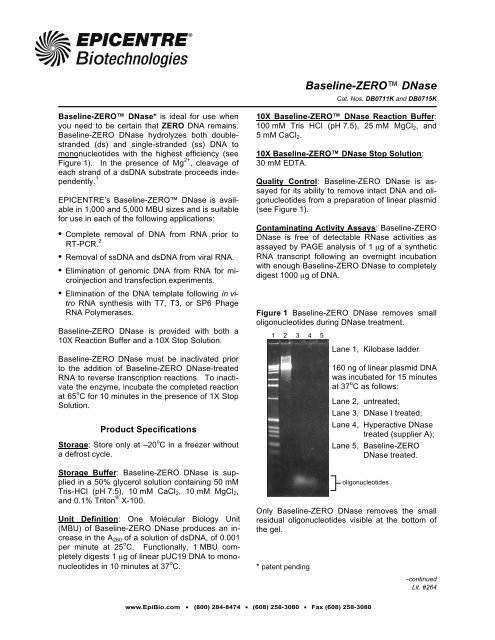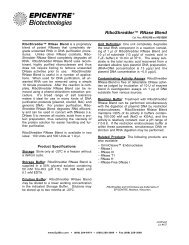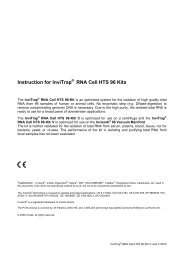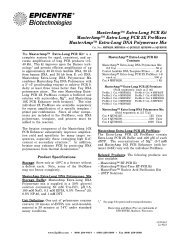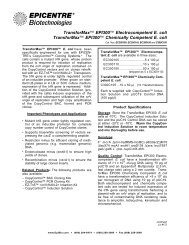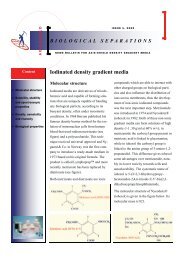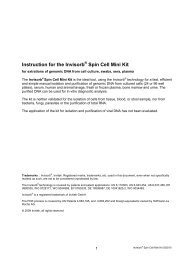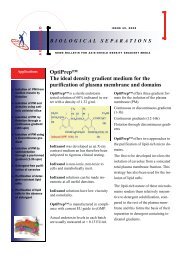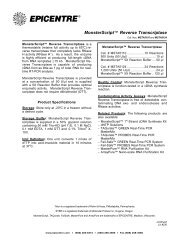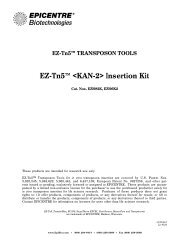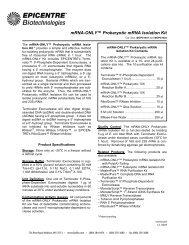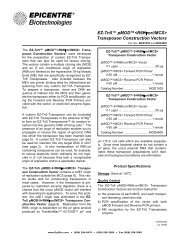Protocol for Baseline-ZERO™ DNase
Protocol for Baseline-ZERO™ DNase
Protocol for Baseline-ZERO™ DNase
Create successful ePaper yourself
Turn your PDF publications into a flip-book with our unique Google optimized e-Paper software.
<strong>Baseline</strong>-ZERO <strong>DNase</strong>Cat. Nos. DB0711K and DB0715K<strong>Baseline</strong>-ZERO <strong>DNase</strong>* is ideal <strong>for</strong> use whenyou need to be certain that ZERO DNA remains.<strong>Baseline</strong>-ZERO <strong>DNase</strong> hydrolyzes both doublestranded(ds) and single-stranded (ss) DNA tomononucleotides with the highest efficiency (seeFigure 1). In the presence of Mg 2+ , cleavage ofeach strand of a dsDNA substrate proceeds independently.1EPICENTRE’s <strong>Baseline</strong>-ZERO <strong>DNase</strong> is availablein 1,000 and 5,000 MBU sizes and is suitable<strong>for</strong> use in each of the following applications:• Complete removal of DNA from RNA prior toRT-PCR. 2• Removal of ssDNA and dsDNA from viral RNA.• Elimination of genomic DNA from RNA <strong>for</strong> microinjectionand transfection experiments.• Elimination of the DNA template following in vitroRNA synthesis with T7, T3, or SP6 PhageRNA Polymerases.<strong>Baseline</strong>-ZERO <strong>DNase</strong> is provided with both a10X Reaction Buffer and a 10X Stop Solution.<strong>Baseline</strong>-ZERO <strong>DNase</strong> must be inactivated priorto the addition of <strong>Baseline</strong>-ZERO <strong>DNase</strong>-treatedRNA to reverse transcription reactions. To inactivatethe enzyme, incubate the completed reactionat 65 o C <strong>for</strong> 10 minutes in the presence of 1X StopSolution.Product SpecificationsStorage: Store only at –20 o C in a freezer withouta defrost cycle.Storage Buffer: <strong>Baseline</strong>-ZERO <strong>DNase</strong> is suppliedin a 50% glycerol solution containing 50 mMTris-HCl (pH 7.5), 10 mM CaCl 2 , 10 mM MgCl 2 ,and 0.1% Triton ® X-100.Unit Definition: One Molecular Biology Unit(MBU) of <strong>Baseline</strong>-ZERO <strong>DNase</strong> produces an increasein the A 260 of a solution of dsDNA, of 0.001per minute at 25 o C. Functionally, 1 MBU completelydigests 1 μg of linear pUC19 DNA to mononucleotidesin 10 minutes at 37 o C.10X <strong>Baseline</strong>-ZERO <strong>DNase</strong> Reaction Buffer:100 mM Tris HCl (pH 7.5), 25 mM MgCl 2 , and5 mM CaCl 2 .10X <strong>Baseline</strong>-ZERO <strong>DNase</strong> Stop Solution:30 mM EDTA.Quality Control: <strong>Baseline</strong>-ZERO <strong>DNase</strong> is assayed<strong>for</strong> its ability to remove intact DNA and oligonucleotidesfrom a preparation of linear plasmid(see Figure 1).Contaminating Activity Assays: <strong>Baseline</strong>-ZERO<strong>DNase</strong> is free of detectable RNase activities asassayed by PAGE analysis of 1 μg of a syntheticRNA transcript following an overnight incubationwith enough <strong>Baseline</strong>-ZERO <strong>DNase</strong> to completelydigest 1000 μg of DNA.Figure 1 <strong>Baseline</strong>-ZERO <strong>DNase</strong> removes smalloligonucleotides during <strong>DNase</strong> treatment.1 2 3 4 5Only <strong>Baseline</strong>-ZERO <strong>DNase</strong> removes the smallresidual oligonucleotides visible at the bottom ofthe gel.* patent pendingLane 1, Kilobase ladder160 ng of linear plasmid DNAwas incubated <strong>for</strong> 15 minutesat 37 o C as follows:Lane 2, untreated;Lane 3, <strong>DNase</strong> I treated;Lane 4, Hyperactive <strong>DNase</strong>treated (supplier A);Lane 5, <strong>Baseline</strong>-ZERO<strong>DNase</strong> treated.oligonucleotidescontinuedLit. #264www.EpiBio.com • (800) 284-8474 • (608) 258-3080 • Fax (608) 258-3088
EPICENTREReferences:1. Sambrook, J. et al., (1989) in: Molecular Cloning:A Laboratory Manual (2nd ed.), ColdSpring Harbor Laboratory Press,New York.2. Kienzle, N. et al., (1996) BioTechniques20, 612.<strong>Baseline</strong>-ZERO <strong>DNase</strong>Related Products: The following products arealso available:– RNase-Free <strong>DNase</strong> I– T7, T3, and SP6 Phage RNA Polymerases– MasterAmp RT-PCR Kits– Plasmid-Safe ATP-Dependent <strong>DNase</strong>– Exonuclease I– Exonuclease III– Exonuclease VII– T5 Exonuclease– T4 Endonuclease V– Lambda Exonuclease– Mung Bean Nuclease– OmniCleave Endonuclease– RecBCD Nuclease– RecJ ExonucleaseGeneral <strong>Baseline</strong>-ZERO <strong>DNase</strong> <strong>Protocol</strong>(Note: The reaction may be scaled up or down as needed.)1. Resuspend the nucleic acid mixture (from any source) in 17 µl of RNase-Free water.2. Add 2 µl of 10X <strong>Baseline</strong>-ZERO <strong>DNase</strong> Reaction Buffer to the sample.3. Add 1 µl (1 MBU) of <strong>Baseline</strong>-ZERO <strong>DNase</strong> to the sample.Note: 1 MBU digests 1 µg of linear pUC19 DNA to dNMPs in 10 minutes at 37 o C.4. Incubate at 37 o C <strong>for</strong> 15-30 minutes.5. Inactivate the <strong>Baseline</strong>-ZERO <strong>DNase</strong> by one of the following means.– Add 2 µl of 10X <strong>Baseline</strong>-ZERO <strong>DNase</strong> Stop Solution to the sample.– Incubate at 65 o C <strong>for</strong> 10 minutes.or– Extract the sample with TE-saturated phenol/chloro<strong>for</strong>m,– followed by a chloro<strong>for</strong>m extraction– followed by a salt/ethanol precipitation.Triton is a registered trademark of Rohm & Haas, Philadelphia, Pennsylvania.<strong>Baseline</strong>-ZERO, MasterAmp, Plasmid-Safe and OmniCleave are trademarks of EPICENTRE, Madison, Wisconsin.page 2 10/09


